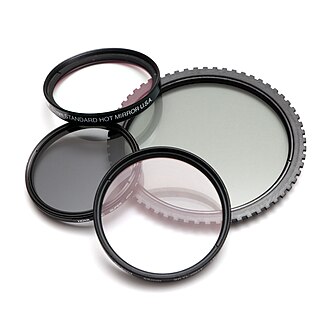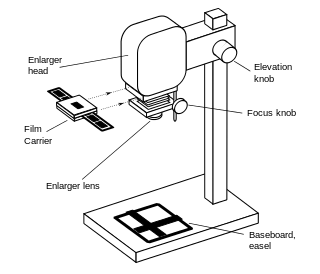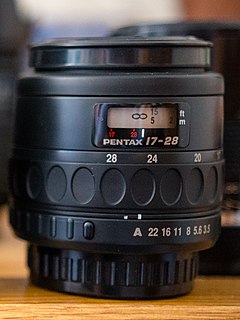
A camera is an optical instrument that captures a visual image. At a basic level, cameras are sealed boxes with a small hole that allows light through to capture an image on a light-sensitive surface. Cameras have various mechanisms to control how the light falls onto the light-sensitive surface. Lenses focus the light entering the camera, and the size of the aperture can be widened or narrowed. A shutter mechanism determines the amount of time the photosensitive surface is exposed to light.

Astrophotography, also known as astronomical imaging, is photography or imaging of astronomical objects, celestial events, and areas of the night sky. The first photograph of an astronomical object was taken in 1840, but it was not until the late 19th century that advances in technology allowed for detailed stellar photography. Besides being able to record the details of extended objects such as the Moon, Sun, and planets, astrophotography has the ability to image objects invisible to the human eye such as dim stars, nebulae, and galaxies. This is done by long time exposure since both film and digital cameras can accumulate and sum light photons over these long periods of time.

Underwater photography is the process of taking photographs while under water. It is usually done while scuba diving, but can be done while diving on surface supply, snorkeling, swimming, from a submersible or remotely operated underwater vehicle, or from automated cameras lowered from the surface.

In photography and cinematography, a filter is a camera accessory consisting of an optical filter that can be inserted into the optical path. The filter can be of a square or oblong shape and mounted in a holder accessory, or, more commonly, a glass or plastic disk in a metal or plastic ring frame, which can be screwed into the front of or clipped onto the camera lens.

An enlarger is a specialized transparency projector used to produce photographic prints from film or glass negatives, or from transparencies.

In infrared photography, the film or image sensor used is sensitive to infrared light. The part of the spectrum used is referred to as near-infrared to distinguish it from far-infrared, which is the domain of thermal imaging. Wavelengths used for photography range from about 700 nm to about 900 nm. Film is usually sensitive to visible light too, so an infrared-passing filter is used; this lets infrared (IR) light pass through to the camera, but blocks all or most of the visible light spectrum.

The Pentax K1000 is an interchangeable lens, 35 mm film, single-lens reflex (SLR) camera, manufactured by Asahi Optical Co., Ltd. from 1976 to 1997, originally in Japan. The K1000's extraordinary longevity makes it a historically significant camera. The K1000's inexpensive simplicity was a great virtue and earned it an unrivaled popularity as a basic but sturdy workhorse. The Pentax K1000 eventually sold over three million units.

The history of photography began in remote antiquity with the discovery of two critical principles: camera obscura image projection and the observation that some substances are visibly altered by exposure to light. There are no artifacts or descriptions that indicate any attempt to capture images with light sensitive materials prior to the 18th century.

The history of the single-lens reflex camera (SLR) begins with the use of a reflex mirror in a camera obscura described in 1676, but it took a long time for the design to succeed for photographic cameras. The first patent was granted in 1861, and the first cameras were produced in 1884, but while elegantly simple in concept, they were very complex in practice. One by one these complexities were overcome as optical and mechanical technology advanced, and in the 1960s the SLR camera became the preferred design for many high-end camera formats.

The Nikon FM10 is a manual focus 35 mm film camera sold by Nikon Corporation. It is of SLR design and was first available in 1995. It is normally sold in a kit that includes a Zoom Nikkor 35–70 mm f/3.5-4.8 zoom lens, although a Zoom Nikkor 70–210 mm f/4.5-5.6 zoom lens is also available. An electronic companion model known as the FE10 was also sold at one stage.

Wildlife photography is a genre of photography concerned with documenting various forms of wildlife in their natural habitat.
Herbert "Burt" Keppler was an American photographer, journalist, author and consultant. His career spanned 57 years, including 37 at Modern Photography and two decades at Popular Photography. He wrote monthly columns and served in the former magazine as Editorial Director and Publisher, and in the latter magazine as Vice President and Publishing Director.

Photographic film is a strip or sheet of transparent film base coated on one side with a gelatin emulsion containing microscopically small light-sensitive silver halide crystals. The sizes and other characteristics of the crystals determine the sensitivity, contrast, and resolution of the film.
Fred Spira (1924–2007) was an inventor and innovator in photography as well as a collector of photographic equipment, images, books, and ephemera. He is credited as one of three individuals who opened up the U.S. market to quality Japanese photographic goods.

The invention of the camera in the early 19th century led to an array of lens designs intended for photography. The problems of photographic lens design, creating a lens for a task that would cover a large, flat image plane, were well known even before the invention of photography due to the development of lenses to work with the focal plane of the camera obscura.

The history of film technology traces the development of techniques for the recording, construction and presentation of motion pictures. When the film medium came about in the 19th century, there already was a centuries old tradition of screening moving images through shadow play and the magic lantern that were very popular with audiences in many parts of the world. Especially the magic lantern influenced much of the projection technology, exhibition practices and cultural implementation of film. Between 1825 and 1840, the relevant technologies of stroboscopic animation, photography and stereoscopy were introduced. For much of the rest of the century, many engineers and inventors tried to combine all these new technologies and the much older technique of projection to create a complete illusion or a complete documentation of reality. Colour photography was usually included in these ambitions and the introduction of the phonograph in 1877 seemed to promise the addition of synchronized sound recordings. Between 1887 to 1894, the first successful short cinematographic presentations were established. The biggest popular breakthrough of the technology came in 1895 with the first projected movies that lasted longer than 10 seconds. During the first years after this breakthrough, most motion pictures lasted about 50 seconds, lacked synchronized sound and natural colour, and were mainly exhibited as novelty attractions. In the first decades of the 20th century, movies grew much longer and the medium quickly developed into one of the most important tools of communication and entertainment. The breakthrough of synchronized sound occurred at the end of the 1920s and that of full color motion picture film in the 1930s. By the start of the 21st century, physical film stock was being replaced with digital film technologies at both ends of the production chain by digital image sensors and projectors.
Norman Rothschild (1913-1995) was an American photographer, artist, and writer.

The smc Pentax-F 17–28mm Fish-eye f/3.5–4.5 is the first fisheye zoom lens, manufactured by Pentax for single-lens reflex cameras (SLRs) with a K lens mount. At its widest setting of 17mm, it affords a 180° diagonal angle of view images for all K-mount full-frame SLR cameras; at 28mm, the diagonal angle of view is reduced to 90° on the diagonal. Typical fisheye barrel distortion is evident at all focal lengths. A successor model, the Pentax DA 10-17mm lens, was introduced with the same view angles and closer focusing capability for APS-C cameras in 2006.
Bob Schwalberg was an American photojournalist and writer on photographic technique and equipment.

Modern Photography was a popular American photo magazine published and internationally distributed for 52 years from New York City. An unrelated Modern Photography magazine was published in Taiwan from 1976.
















